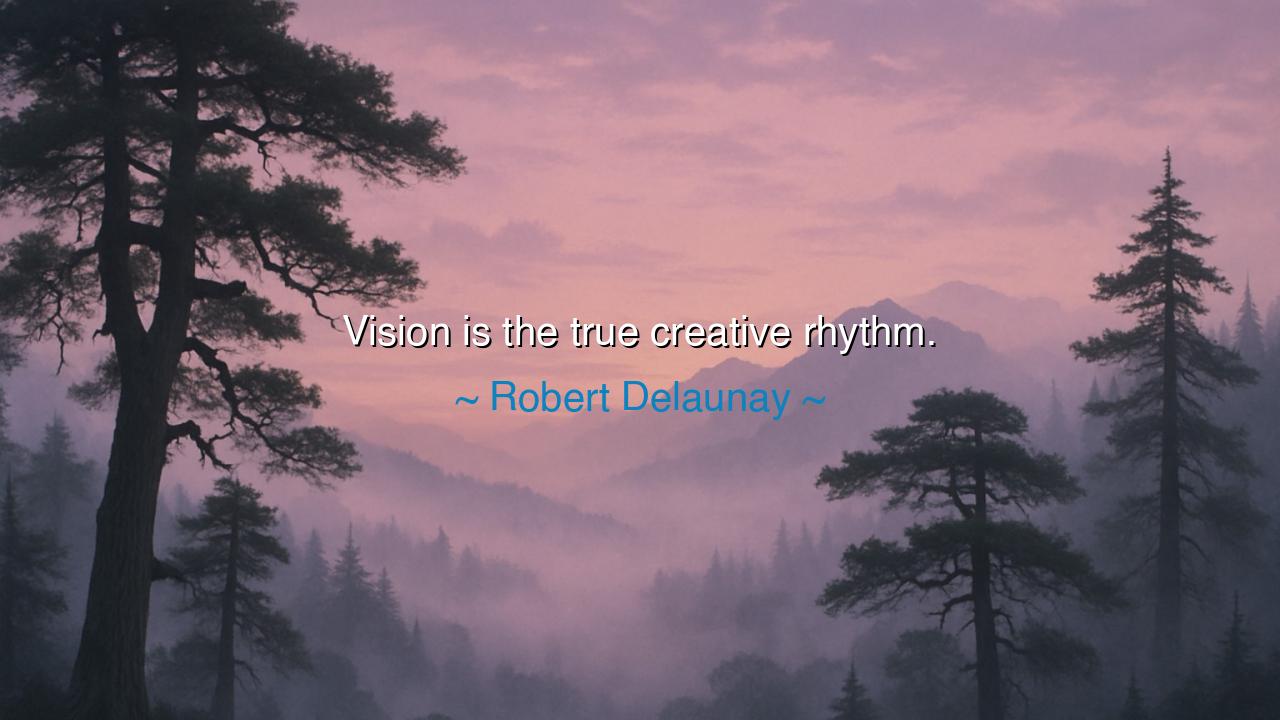
Vision is the true creative rhythm.






The painter Robert Delaunay, whose canvases shimmered with light and color like the living pulse of the universe, once declared: “Vision is the true creative rhythm.” In this brief yet thunderous statement, Delaunay revealed the secret fire of all creation—not technique, not labor, but vision, the sacred rhythm through which the soul dances with the infinite. For Delaunay, art was not imitation, but revelation; not the copying of the visible world, but the birth of new worlds through sight made spiritual. In his eyes, vision was not merely the act of seeing—it was the act of understanding, of perceiving the hidden harmony that moves through all things.
To say that vision is the true creative rhythm is to proclaim that every act of creation, whether in art, thought, or life itself, begins with an inner vibration—a rhythm of perception that connects the eye to the soul, and the soul to the cosmos. The creative rhythm is the heartbeat of existence, and vision is its interpreter. The painter who gazes upon the world and feels its energy flowing through him, the poet who senses patterns in silence, the scientist who perceives order in chaos—all are attuned to this rhythm. Delaunay believed that light itself had music, that color was a language of the divine, and that through vision, man could join the eternal symphony of creation.
Delaunay’s own art was born from this belief. At the dawn of the 20th century, he broke away from the strict geometry of Cubism, seeking something more alive—something that moved, that breathed, that pulsed like sunlight on water. He called his art Orphism, after Orpheus, the mythical musician who charmed all living things with his song. In Delaunay’s paintings, circles and colors swirl like melodies, each hue vibrating with its own energy. He was not painting objects, but the rhythm that exists within them—the movement of light, the breath of the world. Thus, when he said vision is the true creative rhythm, he was not speaking only of art, but of the spiritual rhythm that governs all creation.
Consider, for a moment, the life of Leonardo da Vinci, that eternal seeker of beauty and truth. Leonardo’s genius was not born from skill alone, but from vision—the ability to see what others could not. He saw in the flight of birds the future of flying machines, in the curve of a smile the mystery of the soul, in the patterns of water the hidden laws of motion. He lived attuned to the creative rhythm of nature itself, perceiving in every line, shadow, and motion a deeper harmony. Leonardo’s art and science were not separate pursuits, but two expressions of the same rhythm—the visionary rhythm that animates all creation.
But this rhythm is not reserved for artists alone. It lives within every human being. The farmer who looks upon his field and imagines the harvest before it grows, the teacher who sees potential in the eyes of her students, the leader who envisions peace amid conflict—all are guided by vision. To live without vision is to move through life without music, to work without joy, to act without direction. Yet to live with vision is to find meaning in every gesture, to feel the pulse of purpose beneath even the simplest act. The ancients called this harmony “logos” or “tao”—the living order that binds the seen and unseen.
Yet Delaunay’s teaching carries both inspiration and challenge. For to have vision is not merely to dream—it is to discipline one’s soul to see truly. It demands silence, patience, and faith. One must learn to listen to the rhythm within, to see beyond appearances, to perceive the living energy that moves through all things. The world is full of eyes, yet few truly see; full of sound, yet few truly hear. The visionary, therefore, must cultivate awareness, like a musician tuning his instrument to the divine frequency of truth.
So, my listener, take these words to heart: if you wish to create, first learn to see. Not with the eyes of habit, but with the eyes of wonder. Look upon the world as Delaunay did—as a dance of color and motion, a song of infinite variation. When you find yourself weary, listen for the rhythm beneath the silence; when you feel lost, look again, and let your vision guide you toward the pattern that has always been there. Act not from fear or imitation, but from the deep pulse of insight within you.
For the greatest creators, the wisest thinkers, and the bravest hearts have always known this truth: vision is not only the path to art—it is the rhythm of life itself. To awaken it is to join the universal song, where every color, every sound, every heartbeat plays its part in the vast symphony of being. And when you move in harmony with that rhythm, your life, too, becomes a work of art.






AAdministratorAdministrator
Welcome, honored guests. Please leave a comment, we will respond soon